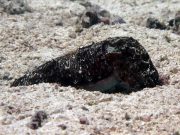Dykning med Sepiablæksprutter
Koh Lantas Marineliv | Sepiidae
Sepia er ikke en fisk, men et bløddyr i klassen Cephalopoda. Der findes over 100 arter på verdensplan, og nogle arter ses jævnligt under dykning på Koh Lanta.
De har store ovale kroppe med en flosset finne langs siderne og får fart på ved at sprøjte vand ud af et rør under hovedet, en slags jetfremdrift. Når de bliver skræmt, sprøjter de et sepiablæk ud, som gør vandet uklart og forvirrer deres fjender.
Alle blæksprutter af typen sepia har en unik indre porøs struktur kaldet en sepia-knogle, og hver art har sin egen tekstur, form og størrelse. De kan justere deres opdrift ved at ændre mængden af gas og væske i deres sepia-knogle.
Deres blod har en usædvanlig blågrøn farve på grund af et kobberprotein, der transporterer ilt i stedet for det røde jernprotein. Deres blod pumpes af 3 separate hjerter. Et til hver gælle, og et tredje pumper blodet rundt i kroppen.
Sepiablæksprutter har otte arme med sugekopper, der omgiver deres giftige næblignende mund, men i modsætning til blæksprutter og kalmars har de også to tentakler, som kan gribe. Sepiablæksprutter foretrækker at spise små krebsdyr og er også kendt for af og til at begå en smule kannibalisme.
Sepiablæksprutter er farveblinde, men deres camouflage er en af de bedste. Det er kromatoforerne i deres hud, der giver dem den fantastiske evne til at matche farven og teksturen på underlaget, selv i totalt mørke. Deres øjne er fuldt udviklede, inden de klækkes, hvilket gør det muligt for dem at observere deres omgivelser, mens de stadig er indkapslet i deres æg.
Under parringssæsonen kan en hun parre sig med flere hanner, lagre sæden og senere beslutte, hvilken der skal befrugte hendes cirka 200 store drueagtige æg. Ungerne er miniatureudgaver af deres forældre og vil begynde at jage med det samme.
2 arter fundet på denne side:
Pharaoh Cuttlefish
(Sepia pharaonis)

Sepia pharaonis @ Hin Bida
The Pharaoh Cuttlefish's body is covered in a mantle which (when not attempting camouflage) is a tan-brown colour, covered with many wavy white lines running from one side, across the back, to the other side. The head is mottled tannish-browning with whitish markings.
The mantle has a mostly white margin, with small brownish bars which create short sections of white spots.
The underside of the fins is white. The underside of the body is a pale to light tan - whitish - pinkish pattern and can change as part of the camouflage routine.
The head is mottled brown, with the arms showing white spots and blotches on the leading edges, and more mottled pattern on the lagging edges.The underside of the arms is white.
As with other cuttlefish, this species can rapidly change the body, head and tentacle colours and patterns which can make identification more difficult.
The adult Pharaoh Cuttlefish are one of the larger cuttlefish species, growing to 43 cm, but usually observed smaller than this, ranging from juveniles a few cm in length, up to around 25 cm for larger individuals. The diet includes small crustaceans, small fish, and other juvenile cuttlefish.
Shortly after spawning, the male Pharaoh Cuttlefish will die, and then, shortly after brooding of the young has finished, the female Pharaoh Cuttlefish will also die.
Needle Cuttlefish
(Sepia aculeata)

Sepia aculeata @ Koh Haa
The Needle Cuttlefish is usually found in shallow areas on sandy bottoms and rubble areas close to coral reefs, occasionally in deeper water.
We are most likely to find this cephalopod around the Koh Haa Lagoon area, or the shallower areas around the Bida Islands, Koh Rok and Koh Phi Phi.
This species has an oblong mantle, with the dorsal usually covered with white blotches, spots or patches. The head and arms have scattered small tubercles (small rounded projections).
Generally the Needle Cuttlefish has a pale brown color, but is capable of rapid color change to match surroundings.
The Needle Cuttlefish usually feed on crustaceans and small fish, growing up to 23 cm in some areas, however specimens caught in the Andaman Sea have mantles varying from 6 cm - 13 cm.
This is an important commercial species, with most animals becoming fully mature in the early months of the year.
Dykning med Sepiablæksprutter omkring Koh Lanta
Dykning og snorkelture
Hvis du gerne vil have chancen for at se Sepiablæksprutter på en af vores daglige dykkerture i højsæsonen fra Koh Lanta, så send os en e-mail til info@diveandrelax.com.
Deltag i vores speedbådsdykkerture i højsæsonen til nogle af Thailands bedste dykkersteder og nyd små grupper, korte rejsetider med fokus på god personlig service, sikkerhed og sjov.
Er du endnu ikke certificeret dykker? Lær at dykke på Koh Lanta med det 3-dages SSI Open Water Diver-kursus.
Book online og spar 10% på dykkerture og dykkerkurser på Koh Lanta.
Få mere at vide
Indo-Stillehavets havdyrsguider
- Allen, G., Steene, R., Humann, P., DeLoach, N. (2003) Reef Fish Identification, Tropical Pacific. Jacksonville, FL., USA: New World Publications, Inc., ISBN 1-878348-36-1.
- Humann, P., DeLoach, N., (2010) Reef Creature Identification, Tropical Pacific. Jacksonville, FL., USA: New World Publications Inc., ISBN 978-1-878348-44-9
- Debelius, H. (2013) Indian Ocean Reef Guide. Frankfurt, Germany: IKAN - Unterwasserarchiv, ISBN 978-3-939767-52-7.
- Debelius, H. (2004) Nudibranchs and Sea Snails, Indo-Pacific Field Guide. Frankfurt, Germany: IKAN - Unterwasserarchiv, ISBN 3-925919-51-1
- Erhardt, H., Knop, D. (2015) Corals Indo-Pacific Field Guide. Frankfurt, Germany: IKAN - Unterwasserarchiv, ISBN 3-925919-69-4.
- Veron J.E.N., Stafford-Smith M.G., Turak E. and DeVantier L.M. (2016). Corals of the World
Flere referencer om havets dyreliv og yderligere information
